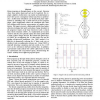Free Online Productivity Tools
i2Speak
i2Symbol
i2OCR
iTex2Img
iWeb2Print
iWeb2Shot
i2Type
iPdf2Split
iPdf2Merge
i2Bopomofo
i2Arabic
i2Style
i2Image
i2PDF
iLatex2Rtf
Sci2ools
ISPASS
2008
IEEE
2008
IEEE
Program Phase Detection based on Critical Basic Block Transitions
Many programs go through phases as they execute. Knowing where these phases begin and end can be beneficial. For example, adaptive architectures can exploit such information to lower their power consumption without much loss in performance. Architectural simulations can benefit from phase information by simulating only a small interval of each program phase, which significantly reduces the simulation time while still yielding results that are representative of complete simulations. This paper presents a lightweight profile-based phase detection technique that marks each phase change boundary in the program’s binary at the basic block level with a critical basic block transition (CBBT). It is independent of execution windows and does not explicitly employ the notion of threshold to make a phase change decision. We evaluate the effectiveness of CBBTs for reconfiguring the L1 data cache size and for guiding architectural simulations. Our CBBT method is as effective at dynamically reduc...
| Added | 31 May 2010 |
| Updated | 31 May 2010 |
| Type | Conference |
| Year | 2008 |
| Where | ISPASS |
| Authors | Paruj Ratanaworabhan, Martin Burtscher |
Comments (0)

